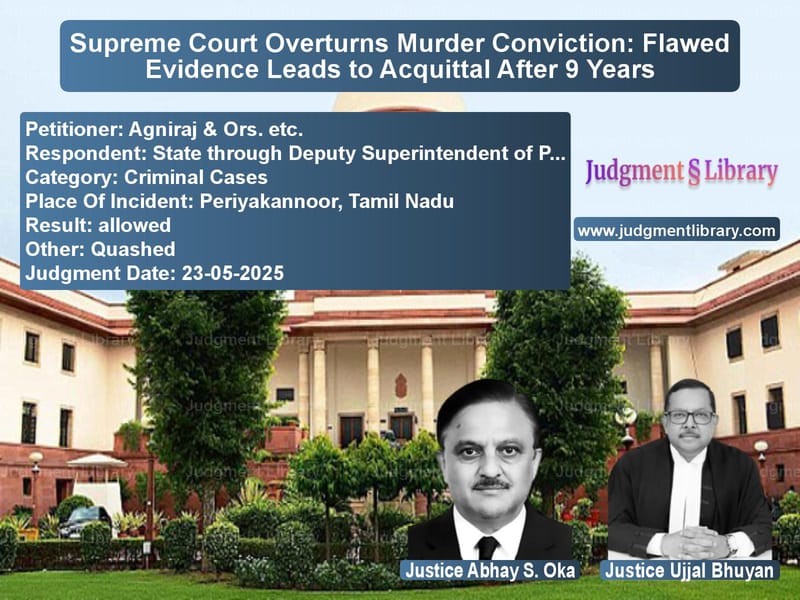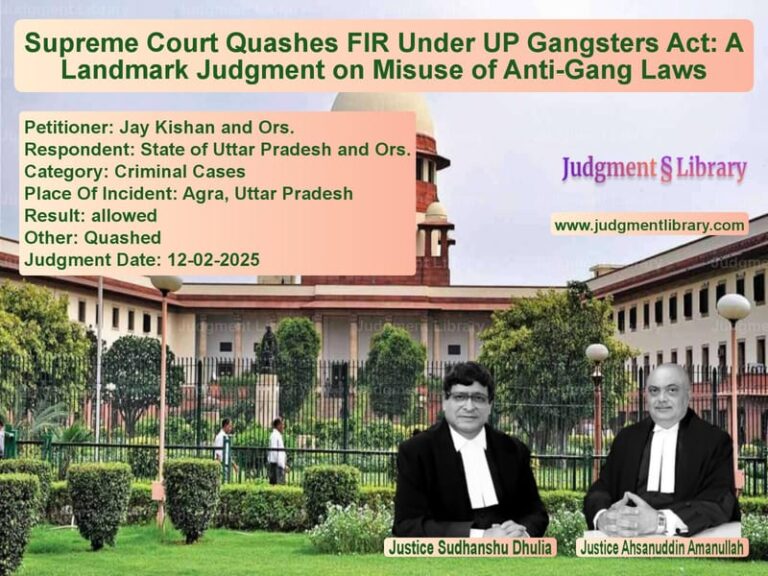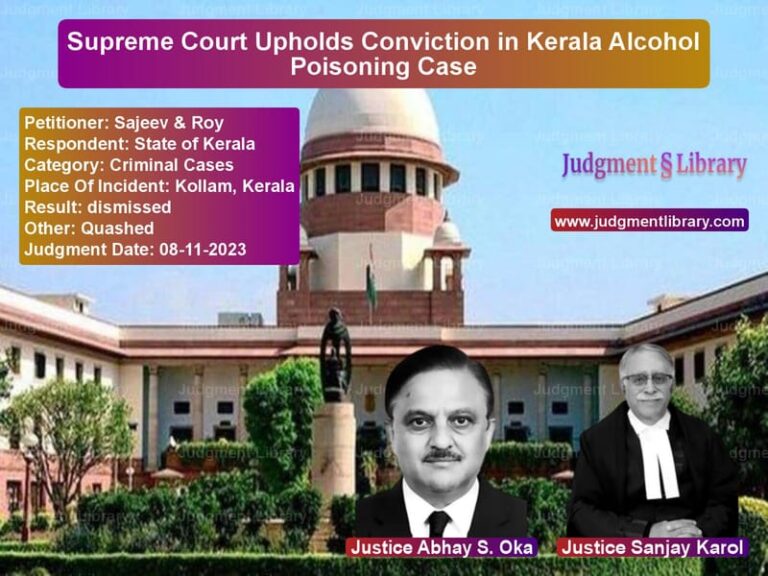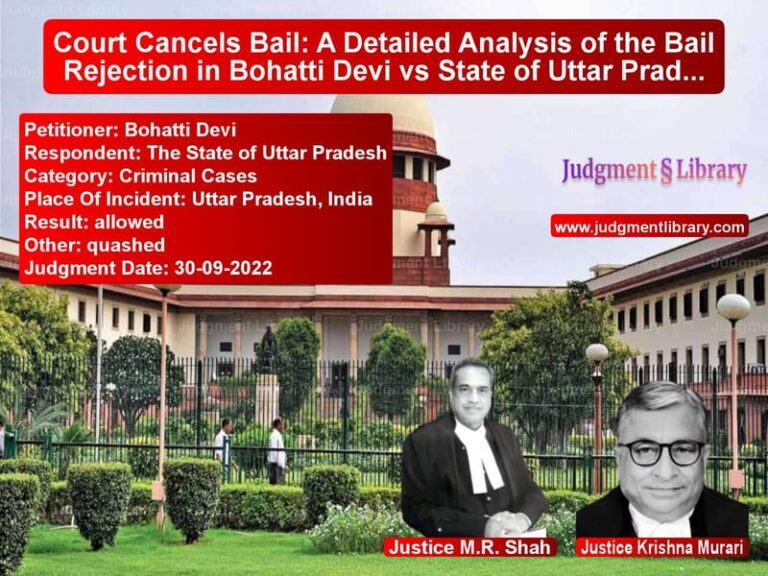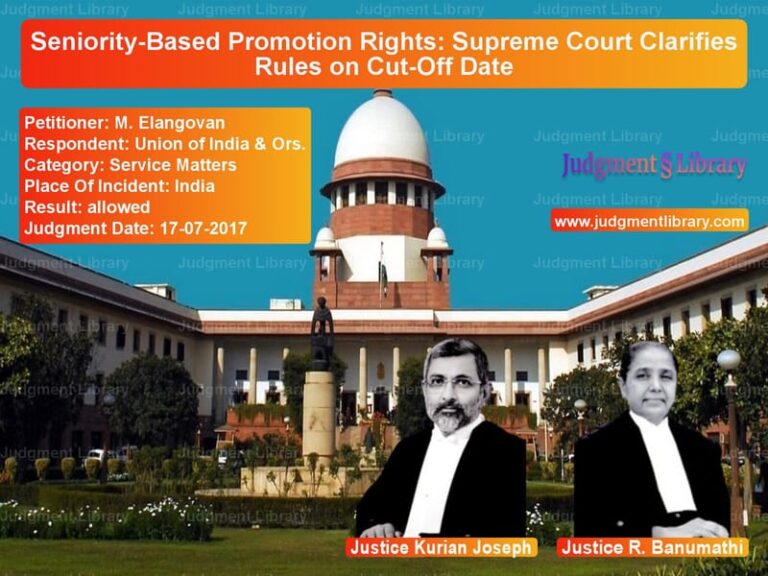Supreme Court Overturns Murder Conviction: Flawed Evidence Leads to Acquittal After 9 Years
In a landmark judgment that underscores the critical importance of reliable evidence in criminal trials, the Supreme Court of India acquitted eleven individuals who had spent over nine years in prison for a brutal triple murder. The case, which originated from a politically charged incident in Tamil Nadu, saw the highest court meticulously examine the prosecution’s evidence and find it severely lacking. The judgment delivered on May 23, 2025, by Justice Abhay S. Oka and Justice Ujjal Bhuyan, serves as a powerful reminder that convictions must be based on solid evidence rather than questionable testimony.
The tragic incident occurred on the night of November 14, 2012, in Periyakannoor, Tamil Nadu. Three people—Kathiresan, his son Prasanna, and their driver Boominathan—were brutally attacked and killed while traveling in a Scorpio car. Kathiresan’s daughter Nikila, then just 7 years old, survived the attack with serious injuries. The prosecution alleged that the attack was politically motivated, stemming from rivalry between two families who had contested local panchayat elections. The wife of the main complainant had defeated the wife of the main accused in the 2011 elections, creating ongoing tension between the families.
The Legal Battle Begins
The case began with a First Information Report registered on November 14, 2012, against thirty accused persons. After investigation, charges were filed against twenty-one individuals. The Trial Court convicted eleven of them and sentenced them to life imprisonment, while acquitting the remaining ten. The High Court later upheld the conviction, leading to the appeal before the Supreme Court.
Arguments Before the Supreme Court
The appellants’ senior counsel raised serious concerns about the quality of evidence presented by the prosecution. He argued that the case rested primarily on three eyewitnesses—PW-1 (Krishnan, the informant), PW-2 (Loorthu Prabhu, a chance witness), and PW-9 (Nikila, the minor daughter of PW-1)—all of whom had material contradictions in their testimonies.
The learned senior counsel appearing for the appellants submitted that “the case of the prosecution is based on three eye witnesses, namely PW-1, PW-2, and PW-9, all of which have material contradictions and cannot be relied upon.” He particularly emphasized the problems with PW-1’s testimony, noting that “this was wholly unreliable as it has material embellishments and exaggerations.”
Regarding PW-2, the counsel pointed out that “PW-2 is a chance witness who allegedly saw the incident with one Abdul Rahman. This PW-2 emerged from thin air after 43 days from the date of the incident and Abdul Rahman has not even been examined.” He argued that this delay and the failure to examine the accompanying witness required drawing an adverse inference against the prosecution.
Concerning the minor witness PW-9, the counsel highlighted procedural lapses: “Regarding PW-9 who was 7 years and 11 months at the time of the incident and was examined at the age of about 9 years, the appellant contends that no preliminary questions were asked. In the absence of voir dire examination, the appellant argues that no reliance can be placed on her statement.”
Read also: https://judgmentlibrary.com/supreme-court-corrects-typographical-error-in-criminal-case-judgment/
The State’s counsel, however, defended the convictions and raised a preliminary objection about the Supreme Court’s jurisdiction. The learned Additional Advocate General appearing for the State “made a distinction between the jurisdiction of this Court under Article 136 of the Constitution of India and Article 134 which is the criminal appellate jurisdiction.” He vehemently submitted that “this Court while exercising jurisdiction under Article 136 has to only consider whether the findings recorded by the High Court or Trial Court suffers from any manifest illegality or perversity and cannot reappreciate evidence.”
The State’s counsel argued that “in cases where there are concurrent findings of conviction such as the present, the learned senior counsel submitted that this Court cannot interfere with such findings by reappreciating evidence.” He maintained that the eyewitness testimonies were reliable and supported by corroborating evidence like fingerprints and weapon recoveries.
The Supreme Court’s Scrutiny of Evidence
The Supreme Court conducted a thorough examination of the evidence and found multiple fatal flaws in the prosecution’s case. The Court began by analyzing the three key eyewitnesses and found each of them unreliable for different reasons.
Regarding PW-1, the Court noted significant issues: “In the evidence of PW-1, it is brought on record that accused No. 1’s wife was defeated by PW-1’s wife (Sathya) in the local panchayat election. The possibility of filing complaint after deliberation with the supporters of AIADMK cannot be ruled out.” The Court observed that “PW-1 (Krishnan) has obviously exaggerated the incident due to their political rivalry.”
The Court particularly noted the witness’s changing statements: “PW-1 (Krishnan) admitted that, in his report, he stated that 36 persons stood around the Scorpio car. Then he came out with the theory that there were 20 persons.” The Court concluded that “the evidence of PW-1 (Krishnan) does not inspire confidence.”
For PW-2, the Court found the delay in coming forward fatal to his credibility: “As far as PW-2 (Loorthu Prabhu) is concerned, for more than one and a half months, he did not approach the police or filed a complaint in any form. He claims to have become wise after a gap of 43 days after hearing a sermon during Christmas. Considering the conduct of the witness of remaining silent for a long period of one and a half months, the testimony of this witness cannot be believed.”
The Court also noted the prosecution’s failure to examine Abdul Rahman, who was allegedly with PW-2 during the incident: “Moreover, he stated that one Abdul Rehman was an eye-witness. However, the prosecution failed to examine him. Therefore, adverse inference will have to be drawn against the prosecution.”
The minor witness PW-9’s testimony was discarded due to procedural violations: “The law is well settled that before proceeding to record the evidence of a minor witness, preliminary questions must be asked by the Court to ascertain whether the witness is able to understand the questions and answer the same. In this case, the age of PW-9 (Nikila) was 10 years. However, preliminary questions were not put to the witness.”
The Court expressed concern about possible tutoring: “From the answers given in the cross-examination that her mother told her the details of what happened to her, the possibility of tutoring the witness cannot be ruled out. Minors are prone to tutoring and in this case, we are dealing with a minor child who was 10 years old.”
Forensic Evidence Under Scrutiny
The Supreme Court also found the forensic evidence presented by the prosecution to be unreliable. The fingerprint evidence, which was crucial to the prosecution’s case, was found to be procedurally flawed.
The Court noted: “The prosecution has heavily relied upon the evidence of fingerprints of accused No. 2 (Agniraj) and accused No. 3 (Sathyaraj) found on the Scorpio car. What is important is that no Mahazar was drawn at the time of taking photographs of the fingerprints allegedly appearing on the Scorpio car. Moreover, the photographs taken were not exhibited.”
The Court emphasized that “The failure of the prosecution to draw a Mahazar or Panchnama at the time of taking photographs of the fingerprints on the car goes to the root of the matter.”
The weapon recovery evidence also raised suspicions: “According to the prosecution, aruvals were recovered at the instance of accused Nos. 2 (Agniraj), 3 (Sathyaraj) and 6 (Yoganathan) from the bush near the shutter of Periya Ooran in Athapadaki village. The recovery is shown from the same place on 5th December, 2012 at three different times.” The Court found this pattern of recoveries from the same location at different times to be unusual and questionable.
Jurisdictional Considerations
The Supreme Court addressed the State’s objection regarding its jurisdiction under Article 136 of the Constitution. The Court referred to established precedents, including Pappu v. State of Uttar Pradesh and Mst Dalbir Kaur and Others v. State of Punjab, which define the scope of the Court’s power in such appeals.
The Court noted that while it generally doesn’t interfere with concurrent findings of fact, it can do so in exceptional circumstances: “In such an appeal by special leave, where the trial court and the High Court have concurrently returned the findings of fact after appreciation of evidence, each and every finding of fact cannot be contested nor such an appeal could be dealt with as if another forum for reappreciation of evidence. Of course, if the assessment by the trial court and the High Court could be said to be vitiated by any error of law or procedure or misreading of evidence or in disregard to the norms of judicial process leading to serious prejudice or injustice, this Court may, and in appropriate cases would, interfere in order to prevent grave or serious miscarriage of justice but, such a course is adopted only in rare and exceptional cases of manifest illegality.”
The Court emphasized that “None of these decisions prevent this Court from reappreciating evidence in a criminal appeal arising out of Article 136 of the Constitution against an order of conviction. Without appreciating the evidence, this Court cannot decide whether the case is within the parameters laid down in the aforesaid decisions.”
The Final Verdict
After thorough analysis, the Supreme Court concluded that the prosecution had failed to prove its case beyond reasonable doubt. The Court found that “the analysis of the evidence of material witnesses made by us shows that the Trial Court and High Court have misread the evidence of these material prosecution witnesses. Very striking features of the prosecution’s case and evidence have been ignored by the Courts.”
The Court summarized its findings: “According to us, if evidence of PW-1 (Krishnan), PW-2 (Loorthu Prabhu) and PW-9 (Nikila) and fingerprints allegedly found are to be ignored, what remains is the evidence of the alleged recovery of weapons at the instance of the accused. Only on the basis of recovery, by no stretch of imagination can the accused be convicted.”
In its final ruling, the Court stated: “Therefore, in this case, interference will have to be made with the impugned judgments. We are of the view that the guilt of the accused has not been proved beyond a reasonable doubt. All the appellants have undergone sentence for more than 9 years and 4 months.”
The Court allowed the appeals, set aside the judgments of the High Court and Trial Court, and acquitted all appellants. They were ordered to be released immediately unless required in any other case.
Broader Implications
This judgment serves as a significant precedent in Indian criminal jurisprudence, emphasizing several crucial principles. It reinforces the requirement for strict adherence to procedural safeguards when dealing with minor witnesses. It highlights the importance of prompt examination of witnesses and the consequences of unexplained delays. The judgment also underscores the necessity of proper documentation and procedure in collecting forensic evidence.
Most importantly, the case demonstrates the Supreme Court’s willingness to intervene in rare cases where lower courts have overlooked glaring deficiencies in evidence, even when there are concurrent findings of guilt. The judgment balances the Court’s general reluctance to reappreciate evidence with its constitutional duty to prevent miscarriages of justice when manifest illegality is apparent.
The acquittal of eleven persons after more than nine years of imprisonment serves as a sobering reminder of the human cost of wrongful convictions and the critical importance of robust evidence in criminal proceedings. While the victims of the horrific crime deserved justice, the Supreme Court’s judgment ensures that this justice is not achieved through questionable means or unreliable evidence.
Petitioner Name: Agniraj & Ors. etc..Respondent Name: State through Deputy Superintendent of Police CB-CID.Judgment By: Justice Abhay S. Oka, Justice Ujjal Bhuyan.Place Of Incident: Periyakannoor, Tamil Nadu.Judgment Date: 23-05-2025.Result: allowed.
Don’t miss out on the full details! Download the complete judgment in PDF format below and gain valuable insights instantly!
Download Judgment: agniraj-&-ors.-etc.-vs-state-through-deputy-supreme-court-of-india-judgment-dated-23-05-2025.pdf
Directly Download Judgment: Directly download this Judgment
See all petitions in Murder Cases
See all petitions in Bail and Anticipatory Bail
See all petitions in Attempt to Murder Cases
See all petitions in Judgment by Abhay S. Oka
See all petitions in Judgment by Ujjal Bhuyan
See all petitions in allowed
See all petitions in Quashed
See all petitions in supreme court of India judgments May 2025
See all petitions in 2025 judgments
See all posts in Criminal Cases Category
See all allowed petitions in Criminal Cases Category
See all Dismissed petitions in Criminal Cases Category
See all partially allowed petitions in Criminal Cases Category

